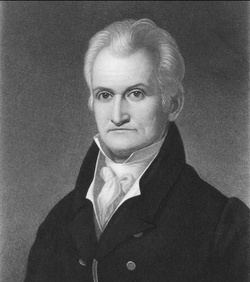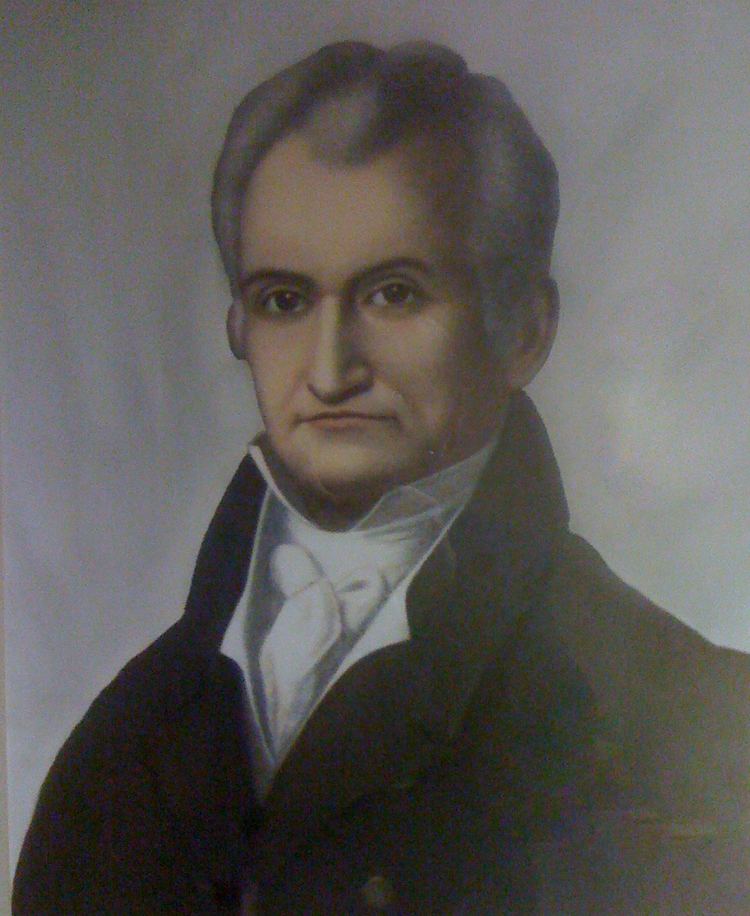Role Political leader Parents Thomas Polk | Preceded by Ephraim McLean Political party Federalist Party Name William Polk Children Lucius Junius Polk | |
 | ||
Succeeded by Robert Ewing/Robert Hayes Spouse Griselda Glichrist (m. 1789) Similar People Thomas Polk, William Lee Davidson, Nathanael Greene, Charles Cornwallis - 1st Marqu, George Washington | ||
Colonel William Polk (9 July 1758 – 14 January 1834) was a North Carolina banker, educational administrator, political leader, renowned Continental officer in the War for American Independence, and survivor of the 1777/1778 encampment at Valley Forge.
Contents
- Early life and background
- American Revolutionary War
- Politician and public servant
- Canovas Washington
- Lafayettes visit to Raleigh
- Service to education
- Marriages and family
- Notable relations
- Death
- Legacy
- References

Early life and background

William Polk was born in Mecklenburg County, North Carolina, on July 9, 1758, the eldest child of Thomas Polk and his wife Sussana Spratt. From the earliest days of rebellion against British authority, Mecklenburg had been a hotbed of revolutionary fervor, and the Polk family was very active in this cause. William's father was commander of the local militia, a rumored key player in adoption of the Mecklenburg Resolves of May 31, 1775, and later colonel of the 4th North Carolina Regiment, Continental Line.
Following their father's example, three of Thomas Polk's sons served as officers in the war against the British. The younger Thomas was killed in action serving alongside his brother William at the Battle of Eutaw Springs.
American Revolutionary War
Lieutenant-Colonels Polk and Middleton were no less conspicuous for their good conduct than their intrepidity, and the troops under their command gave a specimen of what may be expected from men naturally brave when improved by proper discipline.
Politician and public servant
In 1783 the North Carolina General Assembly appointed Polk as Surveyor General of the Middle District, now a part of Tennessee. In this capacity Polk also acquired large tracts of land in the area. Twice he was elected to the House of Commons before returning in 1786 to his native Mecklenburg County. He was re-elected to the House of Commons in 1787, served a one-year term and was re-elected in 1790. He was a candidate for Speaker of the House in 1791, but was defeated by Stephen Cabarrus. That March President George Washington appointed him as Supervisor of Internal Revenue for the District of North Carolina, a position he held for seventeen years, or until the Internal Revenue Laws were repealed.
Polk was among the Continental Army officers who founded the North Carolina Society of the Cincinnati on October 23, 1783.
After the death of his first wife in 1799, Polk moved to property on Blount Street in Raleigh. In December of that year he was elected Grand Master of Masons of North Carolina and served in that office until December 1802.
Federalists in the state legislature nominated him for governor in 1802, but by a two-to-one margin he lost to John Baptista Ashe, a fellow officer in the Revolution. Ashe died before taking office.
Polk was appointed as the first president of the State Bank of North Carolina in 1811 and held that office for eight years.
In March 1812, as war with Britain seemed imminent, President Madison offered Polk a commission as brigadier in the U.S. Army. A Federalist and opponent of the war, he declined the offer. Not until August 1814, when the British sacked Washington, did he change his opposition to the war. Writing his brother-in-law William Hawkins, governor of North Carolina, he offered his services to the state in whatever capacity the governor saw fit. Inasmuch as North Carolina was not seriously threatened, he was not called upon.
In June 1818 Polk became one of the first vice presidents of Raleigh Auxiliary of the American Colonization Society, which sought to resettle free American blacks in a colony in West Africa. This colony developed as Liberia. Polk remained active in the group for many years.
The Federalists nominated him as candidate for governor in 1814, and again he was defeated.
Canova's Washington
After the War of 1812, the North Carolina legislature commissioned the celebrated sculptor Antonio Canova of Venice, Italy, to produce a statue of George Washington for the Statehouse. On Christmas Eve 1821 it arrived in Raleigh and was met with great fanfare, including a 24-gun salute, marching bands, and a parade of both houses of the legislature and the governor. In last position, just ahead of the statue, were veterans of the Revolution, with Polk bearing the Stars and Stripes. Polk also gave a speech that day. The Capitol building burned in June 1831 and the statue was destroyed. An accurate copy of the statue was produced in Italy from preserved molds in the 21st century and installed in the rotunda of the old Capitol building.
Lafayette's visit to Raleigh
Lafayette visited Raleigh in March 1825 as part of his Grand Tour of the United States. Colonel Polk was appointed to give an address on the occasion. After his speech, Polk and Lafayette embraced and wept in memory of what they had shared during the Revolution. Lafayette attended various balls, dinners, and other events, including breakfast at Colonel Polk's home on the morning of March 3.
Service to education
Polk was appointed as a trustee of the University of North Carolina in 1790 and served until his death, including a term as president of the trustees from 1802-1805. Among other educational efforts, he founded a school for sixteen pupils in Raleigh in 1827 and assisted his wife Sarah in founding a school for poor children in 1822.
Marriages and family
In October 1789 Polk married Grizelda Gilchrist, a granddaughter of a former colonial attorney general of North Carolina. She was born in Suffolk, Virginia, on October 24, 1768. The couple had two children, Thomas Gilchrist Polk, born February 22, 1791, and William Julius Polk, born March 21, 1793. Grizelda Polk died in 1799.
On New Year's Day 1801, Polk married Sarah Hawkins. Her brother William later was elected governor of North Carolina. Sarah bore thirteen children, two of whom died in infancy.
Notable relations
Death
Polk died on January 14, 1834, at his home in Raleigh.
His obituary in the January 21, 1834, issue of the Raleigh Register contained the following:
Colonel Polk was at his death the sole surviving field officer of the North Carolina Line; and it will be no disparagement to the illustrious dead to say that no one of his compatriots manifested deeper or more ardent devotion to the cause of his country; that in her service no officer more gallantly exposed his life or more cheerfully endured privation and suffering, and that no one of his rank in the army contributed more by his personal services to bring that glorious contest to a successful end.
—The Raleigh Register, January 21, 1834, quoted by Marshall DeLancey HaywoodLegacy
David Swain, the governor of North Carolina at the time of Polk’s death, said:
He was a contemporary and personal friend of Andrew Jackson, not less heroic in war, and quite as sagacious, and more successful in private life. It is known that Colonel Polk greatly advanced the interests and enhanced the wealth of the hero of New Orleans by information furnished him from his field notes as a surveyor, and in directing Jackson in his selection of valuable tracts of land in the State of Tennessee; that to Samuel Polk, the father of the President (James K. Polk), he gave the agency of renting and selling his (William’s) immense and valuable estate in lands in the most fertile section of that state; that as President of the Bank of North Carolina, he made Jacob Johnson, the father of President Andrew Johnson, its first porter; so that of the three native North Carolinians who entered the White House through the gates of Tennessee, all were indebted alike for the benefactions, and for promotion to a more favorable position in life, to the same individual, Colonel William Polk.
--David Swain, quoted by William H. Polk.